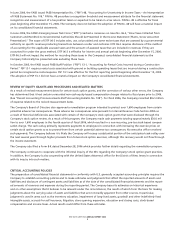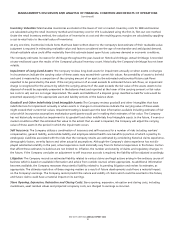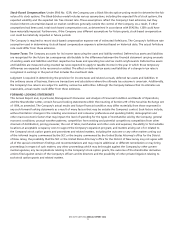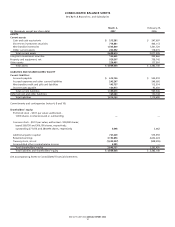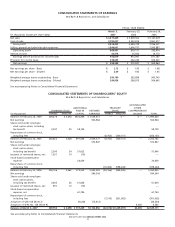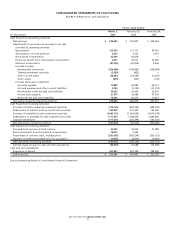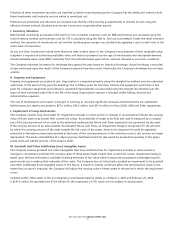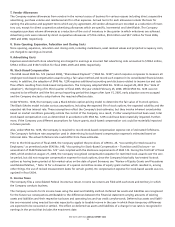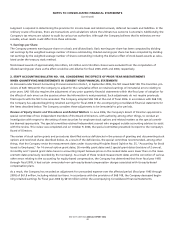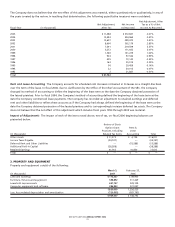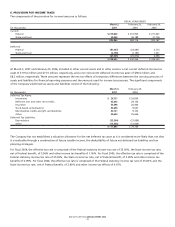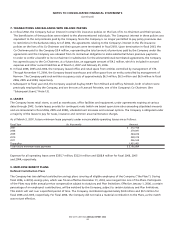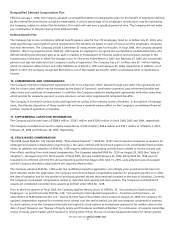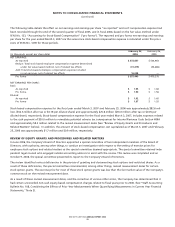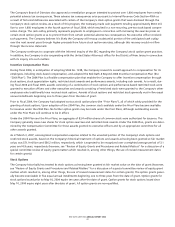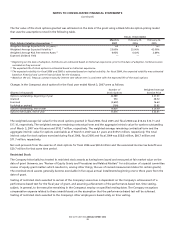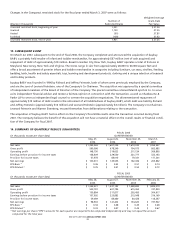Bed, Bath and Beyond 2006 Annual Report Download - page 21
Download and view the complete annual report
Please find page 21 of the 2006 Bed, Bath and Beyond annual report below. You can navigate through the pages in the report by either clicking on the pages listed below, or by using the keyword search tool below to find specific information within the annual report.
BED BATH& BEYOND ANNUAL REPORT 2006
19
T. Vendor Allowances
The Company receives allowances from vendors in the normal course of business for various reasons including direct cooperative
advertising, purchase volume and reimbursement for other expenses. Annual terms for each allowance include the basis for
earning the allowance and payment terms which vary by agreement. All vendor allowances are recorded as a reduction of inven-
tory cost, except for direct cooperative advertising allowances which are specific, incremental and identifiable. The Company
recognizes purchase volume allowances as a reduction of the cost of inventory in the quarter in which milestones are achieved.
Advertising costs were reduced by direct cooperative allowances of $10.6 million, $9.4 million and $8.7 million for fiscal 2006,
2005 and 2004, respectively.
U. Store Opening, Expansion, Relocation and Closing Costs
Store opening, expansion, relocation and closing costs, including markdowns, asset residual values and projected occupancy costs,
are charged to earnings as incurred.
V. Advertising Costs
Expenses associated with store advertising are charged to earnings as incurred. Net advertising costs amounted to $198.4 million,
$158.2 million and $134.5 million for fiscal 2006, 2005 and 2004, respectively.
W. Stock-Based Compensation
The FASB issued SFAS No. 123 (revised 2004), “Share-Based Payment” (“SFAS No. 123R”) which requires companies to measure all
employee stock-based compensation awards using a fair value method and record such expense in its consolidated financial state-
ments. In addition, the adoption of SFAS No. 123R requires additional accounting and disclosure related to income tax and cash
flow effects resulting from stock-based compensation. The Company adopted SFAS No. 123R on August 28, 2005 (the “date of
adoption”), the beginning of its third quarter of fiscal 2005, the year ended February 25, 2006. While SFAS No. 123R was not
required to be effective until the first annual reporting period that began after June 15, 2005, early adoption was encouraged
and the Company elected to adopt before the required effective date.
Under SFAS No. 123R, the Company uses a Black-Scholes option-pricing model to determine the fair value of its stock options.
The Black-Scholes model includes various assumptions, including the expected life of stock options, the expected volatility and the
expected risk free interest rate. These assumptions reflect the Company’s best estimates, but they involve inherent uncertainties
based on market conditions generally outside the control of the Company. As a result, if other assumptions had been used, total
stock-based compensation cost, as determined in accordance with SFAS No. 123R could have been materially impacted. Further-
more, if the Company uses different assumptions for future grants, stock-based compensation cost could be materially impacted
in future periods.
Also, under SFAS No. 123R, the Company is required to record stock-based compensation expense net of estimated forfeitures.
The Company’s forfeiture rate assumption used in determining its stock-based compensation expense is estimated based on
historical data. The actual forfeiture rate could differ from these estimates.
Prior to the third quarter of fiscal 2005, the Company applied the provisions of APB No. 25, “Accounting for Stock Issued to
Employees,” as permitted under SFAS No. 148, “Accounting for Stock-Based Compensation – Transition and Disclosure – an
amendment of FASB Statement No. 123” and complied with the disclosure requirements of SFAS 123. During the first half of fiscal
2005, which ended on August 27, 2005, the Company recognized compensation expense for restricted stock awards over the serv-
ice period, but did not recognize compensation expense for stock options, since the Company historically has treated its stock
options as having been granted at fair market value on the date of grant (however, see “Review of Equity Grants and Procedures
and Related Matters, ” Note 12 for a discussion of a special committee review of equity grant matters which resulted in, among
other things, the use of revised measurement dates for certain grants). No compensation expense for stock-based awards was rec-
ognized in fiscal 2004.
X. Income Taxes
The Company files a consolidated Federal income tax return. Income tax returns are filed with each state and territory in which
the Company conducts business.
The Company accounts for its income taxes using the asset and liability method. Deferred tax assets and liabilities are recognized
for the future tax consequences attributable to the differences between the financial statement carrying amounts of existing
assets and liabilities and their respective tax bases and operating loss and tax credit carryforwards. Deferred tax assets and liabili-
ties are measured using enacted tax rates expected to apply to taxable income in the year in which those temporary differences
are expected to be recovered or settled. The effect on deferred tax assets and liabilities of a change in tax rates is recognized in
earnings in the period that includes the enactment date.


